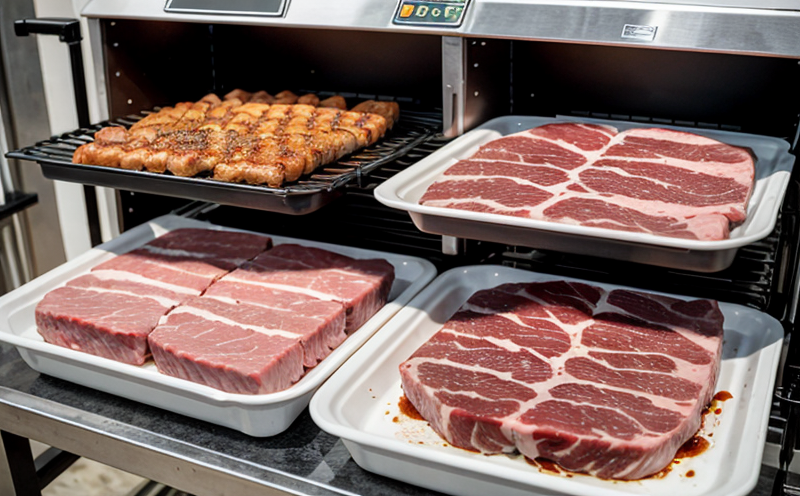ISO 15214 Lactic Acid Bacteria Profiling in Meat and Poultry
The ISO 15214 standard provides a comprehensive framework for the identification, quantification, and characterization of lactic acid bacteria (LAB) in meat and poultry products. This service is particularly important for ensuring food safety, quality control, and compliance with international standards. LAB play a crucial role in food preservation, contributing to product shelf-life extension and sensory characteristics. However, their presence can also lead to spoilage or contamination if not managed properly.
The process begins with the collection of samples from various stages of production, processing, and distribution. Samples are then prepared according to strict protocols outlined in ISO 15214. This involves homogenization, dilution, and plating on selective media suitable for LAB growth. Once colonies appear, they undergo further identification using biochemical tests, PCR-based methods, or matrix-assisted laser desorption/ionization-time of flight mass spectrometry (MALDI-TOF MS).
The significance of this service extends beyond mere compliance with regulations; it offers valuable insights into the microbiological profile of meat and poultry products. By profiling LAB species present in these products, processors can better understand potential sources of contamination or spoilage, optimize fermentation processes, and enhance product shelf-life. This information is invaluable for quality managers looking to improve food safety protocols and ensure consistent product quality.
The service also supports compliance with various international standards, including ISO 15214:2018 which specifies procedures for the enumeration and identification of lactic acid bacteria in meat and poultry products. Compliance ensures that companies meet regulatory requirements set by governmental bodies like the FDA or EU directives on food safety.
Moreover, this profiling can help identify emerging trends in microbial populations within different geographical regions or supply chains. This knowledge allows manufacturers to adapt their production methods accordingly, ensuring they remain competitive while adhering to stringent quality standards.
| Sample Type | Preparation Method |
|---|---|
| Meat Samples | Homogenization followed by dilution and plating on selective media |
| Poultry Samples | Similar to meat samples but may require additional steps for proper preservation of fragile cells due to higher water content. |
Why It Matters
The importance of lactic acid bacteria profiling cannot be overstated, especially within the context of food safety and quality assurance. LAB contribute significantly to the preservation of meat and poultry products through their production of antimicrobial compounds like organic acids and hydrogen peroxide. These natural preservatives help prevent growth of unwanted microorganisms responsible for spoilage or contamination.
However, improper management of LAB can lead to undesirable outcomes such as off-flavors, textural changes, or even increased risk of foodborne illnesses if certain species dominate the microbial community. Therefore, understanding and controlling these bacteria is essential for maintaining product integrity and consumer confidence.
Beyond mere preservation functions, some LAB strains have beneficial health effects when consumed in appropriate quantities. For instance, certain LAB species are used in probiotic supplements or added directly to food products as live cultures. Profiling helps determine which strains are present naturally in raw materials versus those introduced during processing steps.
Additionally, the presence of specific LAB types can indicate particular production practices or geographical origins of ingredients. This information is crucial for traceability efforts and maintaining brand reputation among consumers who increasingly demand transparency regarding ingredient sources and processing methods.
Scope and Methodology
| Objective | To identify, quantify, and characterize lactic acid bacteria in meat and poultry products using standardized techniques compliant with ISO 15214:2018. |
|---|---|
| Type of Samples | Raw materials (meat cuts), intermediate products, finished goods. |
| Main Steps Involved | Sample collection, preparation, inoculation onto selective media, incubation, colony selection, biochemical testing, PCR amplification, sequencing if necessary. |
The scope of this service encompasses all aspects related to the identification and quantification of lactic acid bacteria in meat and poultry products. This includes not only isolating individual strains but also determining their relative abundance within mixed populations found naturally or introduced during processing stages.
Standard operating procedures (SOPs) are strictly followed throughout each step, ensuring accurate results that can be replicated consistently across multiple batches of samples. Compliance with ISO 15214 ensures that the methodologies employed meet industry best practices and align with global standards for food safety and quality assurance.
Competitive Advantage and Market Impact
By offering this specialized service, laboratories can provide unique value to clients operating in sectors where meat and poultry play a significant role. Understanding the LAB microbiome allows companies to innovate more effectively by tailoring their products to meet consumer preferences while maintaining rigorous standards of hygiene and safety.
In competitive markets, having comprehensive data on LAB populations enables firms to differentiate themselves through superior product quality and safer offerings. This knowledge can be leveraged during product development phases or strategic partnerships aimed at enhancing brand image or expanding market reach.
Moreover, the ability to track changes in LAB communities over time provides valuable intelligence for addressing emerging challenges such as antibiotic resistance among microorganisms used in food production processes. Such foresight allows businesses to proactively implement measures that protect public health and bolster their reputation within regulatory frameworks.





